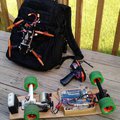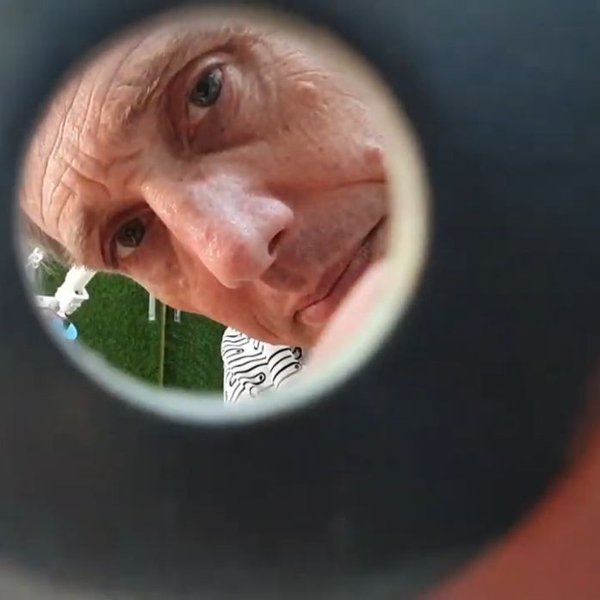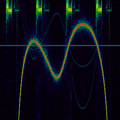-
Hack Chat Transcript, Part 3
11/11/2020 at 21:07 • 0 commentsI mean without
![]() do you mean SDR hardware project?
do you mean SDR hardware project?![]() like community-lead open source hardware
like community-lead open source hardware![]() OK, that was a jam-packed hour! Gonna be a chore to get this transcript posted, that's for sure. But that's a good problem to have. I want to thank Marc for being here today and for this informative and fun Hack Chat. I really appreciate the time today, Marc, thanks so much. And to everyone who attended, same to you -- you made this a great Hack Chat! Feel free to keep the chat going, of course - the Hack CHat is always here for you!
OK, that was a jam-packed hour! Gonna be a chore to get this transcript posted, that's for sure. But that's a good problem to have. I want to thank Marc for being here today and for this informative and fun Hack Chat. I really appreciate the time today, Marc, thanks so much. And to everyone who attended, same to you -- you made this a great Hack Chat! Feel free to keep the chat going, of course - the Hack CHat is always here for you!Don't forget that next week we have a Chat that was rescheduled from October:
![]() check out openhpsdr.org
check out openhpsdr.org![]()
https://hackaday.io/event/175236-harnessing-your-creativity-hack-chat
Harnessing Your Creativity Hack Chat
Leo Fernekes will host the Hack Chat on Wednesday, November 18, 2020 at noon Pacific Time. (Note that this is rescheduled from the original 10/14 date -- we had a little time zone snafu. -- ed) Time zones got you down? Here's a handy time converter!
![]() Yeah glad to have hosted a Hack Chat!
Yeah glad to have hosted a Hack Chat!![]() Hello everyone. Are there SDR software dedicated for digital signals decoding?
Hello everyone. Are there SDR software dedicated for digital signals decoding?![]() thanks for having me
thanks for having me![]() GNU Radio! =)
GNU Radio! =)![]() Pulse NMR, Apply a transmitter pulse then receive the emitted signal
Pulse NMR, Apply a transmitter pulse then receive the emitted signal![]() Thank you!
Thank you!![]() Thanks Marc!!!
Thanks Marc!!!![]() GNU Radio has flowgraphs/blocks for many different comms protocols
GNU Radio has flowgraphs/blocks for many different comms protocols![]() Thanks Marc
Thanks Marc![]() ...and everyone else for their comments!
...and everyone else for their comments!![]() Yeah I didn't realize this awesome community existed, I had just known about hackaday from the articles
Yeah I didn't realize this awesome community existed, I had just known about hackaday from the articles![]() Thanks. need to check that.
Thanks. need to check that.![]() @Marc Lichtman - If you're asking about the user-side, ADSB/FlightAware has a lot of folks contributing radio telemetry of aircraft locations
@Marc Lichtman - If you're asking about the user-side, ADSB/FlightAware has a lot of folks contributing radio telemetry of aircraft locations![]() thank you @Dan Maloney and @Marc Lichtman I took notes and downloaded a few things.
thank you @Dan Maloney and @Marc Lichtman I took notes and downloaded a few things.![]() Thanks marc! Github is the best way to keep the discussion then?
Thanks marc! Github is the best way to keep the discussion then?![]() feel free to check out the textbook, www.pysdr.org, I just recently finished the first version so there might be room for improvement, and I'm always looking for help
feel free to check out the textbook, www.pysdr.org, I just recently finished the first version so there might be room for improvement, and I'm always looking for help![]() @Marc Lichtman IMO, Open Hardware is more of a myth, it will never take of, like Open Software, so don't put much hope in an open HW SDR.
@Marc Lichtman IMO, Open Hardware is more of a myth, it will never take of, like Open Software, so don't put much hope in an open HW SDR.![]() @fid -- I'll be posting a transcript in a few minutes in case you missed anything
@fid -- I'll be posting a transcript in a few minutes in case you missed anything![]() how different (for learning the very basics) is DSP for audio and for rf?
how different (for learning the very basics) is DSP for audio and for rf?![]() yeah email me at pysdr@vt.edu or use github https://github.com/777arc/textbook
yeah email me at pysdr@vt.edu or use github https://github.com/777arc/textbook![]() @Jeffrey Forbes Thanks!
@Jeffrey Forbes Thanks!![]() Oh, sorry, that was @Aaron 's question
Oh, sorry, that was @Aaron 's question![]() "how different (for learning the very basics) is DSP for audio and for rf?" tons of similarities
"how different (for learning the very basics) is DSP for audio and for rf?" tons of similarities![]() but when you get into comms stuff its all new
but when you get into comms stuff its all new![]() thanks @Dan Maloney
thanks @Dan Maloney -
Hack Chat Transcript, Part 2
11/11/2020 at 21:05 • 0 commentsEttus support is fantastic from my experience
![]() and I don't have any affiliations with them
and I don't have any affiliations with them![]() and LimeSDR support has been like super bad, I had a couple bricked Limes early on
and LimeSDR support has been like super bad, I had a couple bricked Limes early on![]() And part of that: is there a good way to map out the power output as a function of frequency?
And part of that: is there a good way to map out the power output as a function of frequency?![]() from my experience
from my experience![]() @Aaron a lot of FPGAs include DSP blocks that are good for implementing FIR filters
@Aaron a lot of FPGAs include DSP blocks that are good for implementing FIR filters![]() sorry if there are Lime folks here
sorry if there are Lime folks here![]() I'll have to look into that NMR app later
I'll have to look into that NMR app later![]() hadnt seen it before
hadnt seen it before![]() keep in mind, when someone uses a certain SDR for a certain app, 99% of the time they could have used a different SDR
keep in mind, when someone uses a certain SDR for a certain app, 99% of the time they could have used a different SDR![]() so it really comes down to being familiar with the API
so it really comes down to being familiar with the API![]() and having code examples and such
and having code examples and such![]() NMR is super useful for my work so it def caught my attention
NMR is super useful for my work so it def caught my attention![]() looks like there's a range of possibilities with various rf-freq measurement of materials.
looks like there's a range of possibilities with various rf-freq measurement of materials.![]() yeah I wouldn't put much emphasis on the LimeSDR part
yeah I wouldn't put much emphasis on the LimeSDR part![]() they probably could have used several other SDRs
they probably could have used several other SDRs![]() Point taken
Point taken![]() SDRs are very general purpose
SDRs are very general purpose![]() Will this chat transcript be available later?
Will this chat transcript be available later?![]() @perronemajr - Any idea how old that NMR article is? Might make a good Hackaday writeup if it's still pretty fresh.
@perronemajr - Any idea how old that NMR article is? Might make a good Hackaday writeup if it's still pretty fresh.![]() and like I said, the way I usually use them is to deliver the baseband IQ samples to my host machine, where they get processed
and like I said, the way I usually use them is to deliver the baseband IQ samples to my host machine, where they get processed![]() That's why I asked if there was a good way of mapping the power output
That's why I asked if there was a good way of mapping the power output![]() I only rarely modify the FPGA on the SDR itself
I only rarely modify the FPGA on the SDR itself![]() because if you can map it out for hackrf one then you can use that instead
because if you can map it out for hackrf one then you can use that instead![]() @Aaron - Yes, absolutely. I'll post it right after the chat.
@Aaron - Yes, absolutely. I'll post it right after the chat.![]() yeah and another SDR uses the same FPGA or RFIC then there's less work to do
yeah and another SDR uses the same FPGA or RFIC then there's less work to do![]() Great, Thanks! Some of us are still at work.. shhhh... =)
Great, Thanks! Some of us are still at work.. shhhh... =)![]() Thanks Dan
Thanks Dan![]() or if the app didn't involve modifying the FPGA, you can probably sub them out with little effort
or if the app didn't involve modifying the FPGA, you can probably sub them out with little effort![]() like if all the DSP is happening on the host machine, its easy to swap SDRs
like if all the DSP is happening on the host machine, its easy to swap SDRs![]() the SDR is just a frequency-agile receiver (or transmitter) in that case
the SDR is just a frequency-agile receiver (or transmitter) in that case![]() I think it did modify the FPGA, according to the paper written
I think it did modify the FPGA, according to the paper written![]() yeah
yeah![]() Will check again though
Will check again though![]() so then you would want to check how big an FPGA is needed
so then you would want to check how big an FPGA is needed![]() And look for ways around
And look for ways around![]() like the PlutoSDR has almost no room left on the FPGA for custom stuff
like the PlutoSDR has almost no room left on the FPGA for custom stuff![]() but USRP B210 I think has a lot of room
but USRP B210 I think has a lot of room![]() not sure about HackRF
not sure about HackRF![]() bigger FPGAs cost a lot more
bigger FPGAs cost a lot more![]() so when you see more expensive SDRs, that might be one reason, larger FPGA
so when you see more expensive SDRs, that might be one reason, larger FPGA![]() I like to do my DSP on the host side, for the sake of rapid development
I like to do my DSP on the host side, for the sake of rapid development![]() but if you need to do some DSP at "high rate", sometimes it has to be done on the FPGA
but if you need to do some DSP at "high rate", sometimes it has to be done on the FPGA![]() What's a good budget SDR with an FPGA at least as large as the one lime has?
What's a good budget SDR with an FPGA at least as large as the one lime has?![]() using GNU Radio, I swap between USRP B200mini and a Pluto with almost zero effort for transmit and receive
using GNU Radio, I swap between USRP B200mini and a Pluto with almost zero effort for transmit and receive![]() yeah GNU Radio is all about doing DSP on the host, until you get into RFNoC
yeah GNU Radio is all about doing DSP on the host, until you get into RFNoC![]() I dont know exactly how large the Lime's is, but considering the price its probably on the smaller end
I dont know exactly how large the Lime's is, but considering the price its probably on the smaller end![]() you can see how many LUTs or however they measure the size of the FPGA
you can see how many LUTs or however they measure the size of the FPGA![]() its an Intel, not Xilinx, so might be harder to compare, not sure
its an Intel, not Xilinx, so might be harder to compare, not sure![]() Wikipedia is great: https://en.wikipedia.org/wiki/List_of_software-defined_radios checking now
Wikipedia is great: https://en.wikipedia.org/wiki/List_of_software-defined_radios checking now![]() FPGA development is like a whole other thing =P
FPGA development is like a whole other thing =P![]() lots of jobs out there for FPGA devs, if any students are in the chat
lots of jobs out there for FPGA devs, if any students are in the chat![]() Makes me want to ask, the BladeRF Micro has two choices between 40k and 300k LEs. Any idea what kind of applications would require the much larger chip?
Makes me want to ask, the BladeRF Micro has two choices between 40k and 300k LEs. Any idea what kind of applications would require the much larger chip?![]() Have you tried the pynq board for python to fpga?
Have you tried the pynq board for python to fpga?![]() get good with FPGA dev, and learn DSP basics (eg with www.pysdr.org) and you'll have a lot of opportunities
get good with FPGA dev, and learn DSP basics (eg with www.pysdr.org) and you'll have a lot of opportunities![]() 40k already "feels" like a lot but I imagine the DSP gets very heavy on resource usage
40k already "feels" like a lot but I imagine the DSP gets very heavy on resource usage![]() Doesn't list one for hackrf; perhaps it doesn't have one? Or maybe it's just very small
Doesn't list one for hackrf; perhaps it doesn't have one? Or maybe it's just very small![]() any app that requires a lot of DSP on the FPGA will need the larger one. The smaller one has just enough room for the existing code, I believe, it's not intended to add much to
any app that requires a lot of DSP on the FPGA will need the larger one. The smaller one has just enough room for the existing code, I believe, it's not intended to add much to![]() the HackRF just has a very small CPLD for glue logic, no FPGA
the HackRF just has a very small CPLD for glue logic, no FPGA![]() oh ok
oh ok![]() yeah I mean most of the apps I made did not involve adding to the FPGA
yeah I mean most of the apps I made did not involve adding to the FPGA![]() I always prefer not to do FPGA dev, unless its necessary
I always prefer not to do FPGA dev, unless its necessary![]() in fact i like to stay within Python, where most folks use C/C++ for SDR apps
in fact i like to stay within Python, where most folks use C/C++ for SDR apps![]() so I prefer SDRs with good Python APIs, which most have
so I prefer SDRs with good Python APIs, which most have![]() usually the heavy lifting it done in C, and they use pybind or something for the Python API
usually the heavy lifting it done in C, and they use pybind or something for the Python API![]() so dont think you are going to have a huge performance hit by using Python for your SDR app
so dont think you are going to have a huge performance hit by using Python for your SDR app![]() like most numpy functions are implemented in C, and very performant
like most numpy functions are implemented in C, and very performant![]() It will depend on the device installed on.
It will depend on the device installed on.![]() RE "40k already "feels" like a lot but I imagine the DSP gets very heavy on resource usage" dont forget about everything the company had to add
RE "40k already "feels" like a lot but I imagine the DSP gets very heavy on resource usage" dont forget about everything the company had to add![]() yeah for sure
yeah for sure![]() I tried using the Raspberry Pi, it was SLOW..
I tried using the Raspberry Pi, it was SLOW..![]() yeah I like to use x86 platforms whenever I can, for rapid development sake
yeah I like to use x86 platforms whenever I can, for rapid development sake![]() rpi 3 or 4?
rpi 3 or 4?![]() Ive been enjoying using these x86 based single board computers that have either Atoms or full Core CPUs on them
Ive been enjoying using these x86 based single board computers that have either Atoms or full Core CPUs on them![]() Could the DSP be moved to the computer instead of FPGA? for NMR or EPR real time isn't needed; just needs to scan through the frequencies
Could the DSP be moved to the computer instead of FPGA? for NMR or EPR real time isn't needed; just needs to scan through the frequencies![]() About Pi I was jsut on that page: The SDR Linux Distro for Raspberry Pi https://pisdr.luigi.ltd/
About Pi I was jsut on that page: The SDR Linux Distro for Raspberry Pi https://pisdr.luigi.ltd/![]() "Could the DSP be moved to the computer instead of FPGA" Always!!!!
"Could the DSP be moved to the computer instead of FPGA" Always!!!!![]() just depends how many samples you want to pump through
just depends how many samples you want to pump through![]() Well that's encouraging: I'll take a look
Well that's encouraging: I'll take a look![]() a given realtime app can usually be performed near-realtime by using CPU instead of FPGA
a given realtime app can usually be performed near-realtime by using CPU instead of FPGA![]() I can do the basic GNU Radio stuff on an rPi, but it can be overloaded with higher sample rates
I can do the basic GNU Radio stuff on an rPi, but it can be overloaded with higher sample rates![]() I started making an SDR image for the PI.. Great idea! I would love to try someone elses..
I started making an SDR image for the PI.. Great idea! I would love to try someone elses..![]() and i would recommend that if you're a hobbyist, you can always port the functionality to the FPGA later
and i would recommend that if you're a hobbyist, you can always port the functionality to the FPGA later![]() I've done stuff on the Pi, but I usually do the development on a powerful machine, then make sure it can run fast enough on the Pi
I've done stuff on the Pi, but I usually do the development on a powerful machine, then make sure it can run fast enough on the Pi![]() its just more rapid development that way
its just more rapid development that way![]() True..
True..As someone looking to move the functionality out of the CPU/PC into the FPGA, what resources do people recommend?
![]() well you'll need to learn FPGA development
well you'll need to learn FPGA development![]() so might want to start with a dev kit for whatever ecosystem you plan to use (e.g. Vivado)
so might want to start with a dev kit for whatever ecosystem you plan to use (e.g. Vivado)![]() like an Artix based board, which can be had for less than $100
like an Artix based board, which can be had for less than $100![]() Plus there are several companies. You have to stick with the one that has the most for your application.
Plus there are several companies. You have to stick with the one that has the most for your application.![]() you can use the free Vivado license if your FPGA is small enough
you can use the free Vivado license if your FPGA is small enough![]() yeah figure out which FPGA you will have to target
yeah figure out which FPGA you will have to target![]() Like Altera, I use them, but xilinx has some features that seem better for certain applications.
Like Altera, I use them, but xilinx has some features that seem better for certain applications.![]() like switching from Xilinx to Intel is unlike any other switch I can think of
like switching from Xilinx to Intel is unlike any other switch I can think of![]() Intel/Altera
Intel/Altera![]() I am excited they bought Altera..
I am excited they bought Altera..![]() During remoticon I set up the PiSDR on a RasPi3 and it runs nicely.
During remoticon I set up the PiSDR on a RasPi3 and it runs nicely.![]() yeah same
yeah same![]() I can't wait to try GNU Radio on the pi 4..
I can't wait to try GNU Radio on the pi 4..![]() in the SDR world, Xilinx has been the dominant force
in the SDR world, Xilinx has been the dominant force![]() as well as US gov
as well as US gov![]() AMD recently bought xilnix
AMD recently bought xilnix![]() the SDRs that use Intel/Altera did it to save money =P
the SDRs that use Intel/Altera did it to save money =P![]() yeah AMD has been insane lately
yeah AMD has been insane lately![]() Gnu radio + rpi4 = personal space heater
Gnu radio + rpi4 = personal space heater![]() they are crushing it on all fronts
they are crushing it on all fronts![]() for a pre-built ISO image for GNU Radio for rPi, look at https://github.com/luigifcruz/pisdr-image
for a pre-built ISO image for GNU Radio for rPi, look at https://github.com/luigifcruz/pisdr-image![]() You also have to make sure your FPGA dev board has enought memory for what you need to do.
You also have to make sure your FPGA dev board has enought memory for what you need to do.![]() Thanks Barry.. I am going to try that!
Thanks Barry.. I am going to try that!![]() The AMD CEO knows what she is doing.
The AMD CEO knows what she is doing.![]() from a branding perspective, Altera switched to Intel, but I doubt Xilinx will switch their branding
from a branding perspective, Altera switched to Intel, but I doubt Xilinx will switch their branding![]() I think it was because Altera was losing the race and Intel had always been a big name
I think it was because Altera was losing the race and Intel had always been a big name![]() what about synchronization of multiple receivers? antenna arrays, time-of-arrival passive radars...?
what about synchronization of multiple receivers? antenna arrays, time-of-arrival passive radars...?![]() well when I suggested FPGA dev board, that was purely for learning FPGA dev
well when I suggested FPGA dev board, that was purely for learning FPGA dev![]() @kiggins.chris :-D That's the reason I have a fan on the RasPi3.
@kiggins.chris :-D That's the reason I have a fan on the RasPi3.What about tips specifically for implementing DSP in HDL?
![]() i wouldnt get too caught up in the capabilities of the dev board, since you will likely be switching to the FPGA onboard your SDR
i wouldnt get too caught up in the capabilities of the dev board, since you will likely be switching to the FPGA onboard your SDR![]() "what about synchronization of multiple receivers? antenna arrays, time-of-arrival passive radars...?" yeah thats an important consideration
"what about synchronization of multiple receivers? antenna arrays, time-of-arrival passive radars...?" yeah thats an important consideration![]() Aaron: it also has some other good apps with it
Aaron: it also has some other good apps with it![]() I've done work using USRP X310's that were synced over PPS/10MHz, and also work with SDRs synced over GPS
I've done work using USRP X310's that were synced over PPS/10MHz, and also work with SDRs synced over GPS![]() I don't have tips for implementing DSP in HDL =P
I don't have tips for implementing DSP in HDL =P![]() learn DSP from a conceptual/algorithmic POV
learn DSP from a conceptual/algorithmic POV![]() then also get good with FPGA dev
then also get good with FPGA dev![]() When you start talking about getting multiple coherent channels using SDRs, you get into the more expensive SDRs (unless you just need 2 channels which the B210 can do)
When you start talking about getting multiple coherent channels using SDRs, you get into the more expensive SDRs (unless you just need 2 channels which the B210 can do)![]() and that coherency is required for angle-of-arrival and phased arrays
and that coherency is required for angle-of-arrival and phased arrays![]() What types of AI/ML techniques or algorithms have you implemented in SDR? What kind of benefits/improvements do they provide?
What types of AI/ML techniques or algorithms have you implemented in SDR? What kind of benefits/improvements do they provide?![]() I've done quite a bit of ML apps, but they were always implemented at the host side
I've done quite a bit of ML apps, but they were always implemented at the host side![]() since the ML tends to happen at the end of the chain, after any DSP preprocessing and such
since the ML tends to happen at the end of the chain, after any DSP preprocessing and such![]() can a syncing signal be added to the input signals and then numerically isolated?
can a syncing signal be added to the input signals and then numerically isolated?![]() I mean folks have implemented stuff like DNN inference into FPGAs
I mean folks have implemented stuff like DNN inference into FPGAs![]() well even with a syncing signal you still need coherent receivers
well even with a syncing signal you still need coherent receivers![]() the sync signal will fix any constant phase shift that might exist
the sync signal will fix any constant phase shift that might exist![]() but the sync signal is usually over a wire, right?
but the sync signal is usually over a wire, right?![]() Are SDR outputs delicate to reflected waves? for NMR you basically need to put the transmitter and reciever in a Faraday cage together which means the amplitudes can get pretty high
Are SDR outputs delicate to reflected waves? for NMR you basically need to put the transmitter and reciever in a Faraday cage together which means the amplitudes can get pretty high![]() because otherwise it might reach the two apertures at different times
because otherwise it might reach the two apertures at different times![]() "Are SDR outputs delicate to reflected waves" yes!!! make sure if you are transmitting, you use a well-matched antenna
"Are SDR outputs delicate to reflected waves" yes!!! make sure if you are transmitting, you use a well-matched antenna![]() Is it possible to use the reciever as a sink for the energy?
Is it possible to use the reciever as a sink for the energy?![]() oh but in a faraday cage your reflections shouldnt be that high
oh but in a faraday cage your reflections shouldnt be that high![]() hmm good question
hmm good question![]() can be wire, can be laser, can be separate radio channel, can be third-party transmitter, can be something gps-derived...
can be wire, can be laser, can be separate radio channel, can be third-party transmitter, can be something gps-derived...![]() if you end up receiving at too high a level, just stick an attenutator on the rx port
if you end up receiving at too high a level, just stick an attenutator on the rx port![]() in faraday cage the reflections can be sky-high. see microwave oven. but it could be lined by a rf absorber.
in faraday cage the reflections can be sky-high. see microwave oven. but it could be lined by a rf absorber.![]() ^
^![]() but high compared to a poorly matched antenna that reflects half the power back?
but high compared to a poorly matched antenna that reflects half the power back?![]() You'd basically be getting all the power back
You'd basically be getting all the power back![]() I guess im confusing rx and tx sides of the SDR which have different hardware
I guess im confusing rx and tx sides of the SDR which have different hardware![]() oh geez, yeah def add an attenuator to the rx side then
oh geez, yeah def add an attenuator to the rx side then![]() Especially in NMR where you're resonating the material
Especially in NMR where you're resonating the material![]() Transmitter / receiver switching for NMR is a solved problem.
Transmitter / receiver switching for NMR is a solved problem.![]() the SDR data sheets usually have a max input on the RF connector in dBm
the SDR data sheets usually have a max input on the RF connector in dBm![]() Got it; attenuator was the search term I needed
Got it; attenuator was the search term I neededWhen designing an SDR, do you recommend starting with the tx side or rx side? Why?
![]() what about radar? something pretty cool could be pinging the moon.
what about radar? something pretty cool could be pinging the moon.![]() designing an SDR, or SDR app?
designing an SDR, or SDR app?![]() also did that NMR app include an added T/R switch?
also did that NMR app include an added T/R switch?![]() or did they just use the TX and RX ports separately
or did they just use the TX and RX ports separatelyAn SDR, hardwire and softwaer
![]() if you are interested in designing an SDR itself, I would join whatever the largest open source hardware project is
if you are interested in designing an SDR itself, I would join whatever the largest open source hardware project is![]() it's an enormous task
it's an enormous task![]() @Thomas Shaddack https://www.technologyreview.com/2019/08/23/75512/quantum-radar-has-been-demonstrated-for-the-first-time/ cool stuff, don't know why they mentioned it considering certain things...
@Thomas Shaddack https://www.technologyreview.com/2019/08/23/75512/quantum-radar-has-been-demonstrated-for-the-first-time/ cool stuff, don't know why they mentioned it considering certain things...![]() what if you just shit out PCBs like its no thing ?
what if you just shit out PCBs like its no thing ?![]() Yet, china sells the chips for pennies... LOL
Yet, china sells the chips for pennies... LOL![]() anyone know what the biggest open hardware SDR project is?
anyone know what the biggest open hardware SDR project is?![]() That's why I mentioned squeezed states
That's why I mentioned squeezed states![]() yeah if you just want an SDR, buy one, lol
yeah if you just want an SDR, buy one, lol![]() With NMR there is typically only one coil for transmit and receive.
With NMR there is typically only one coil for transmit and receive.![]() but I would avoid the chinese clones if it's your first SDR
but I would avoid the chinese clones if it's your first SDR![]() Agreed... What is the larges SDR open source project?
Agreed... What is the larges SDR open source project?![]() for learning DSP, and how to use SDRs, definitely start with the RX side
for learning DSP, and how to use SDRs, definitely start with the RX side![]() now keep in mind, stuff like USRPs have their schematics publicly available, and firmware is open source
now keep in mind, stuff like USRPs have their schematics publicly available, and firmware is open source![]() Besides GNU radio?
Besides GNU radio?![]() well GNU Radio is the software/DSP/GUI side of the SDR app
well GNU Radio is the software/DSP/GUI side of the SDR app![]() @Jeffrey Forbes Seems to be, just wasn't aware of that stuff, being more in physics than electrical eng.
@Jeffrey Forbes Seems to be, just wasn't aware of that stuff, being more in physics than electrical eng.![]() For DSP? Or for hardware?
For DSP? Or for hardware?![]() Anyone looked at HPSDR?
Anyone looked at HPSDR?![]() GNU Radio competitors include Pothos(sp?) and maybe Red Hawk
GNU Radio competitors include Pothos(sp?) and maybe Red Hawk![]() but you don't need a framework like GNU Radio to create an SDR app
but you don't need a framework like GNU Radio to create an SDR app![]() GNU Radio just makes it easier to re-use other people's work, and share your work
GNU Radio just makes it easier to re-use other people's work, and share your work![]() HackRF is open source...
HackRF is open source...![]() so you dont have to reinvent the wheel
so you dont have to reinvent the wheel![]() yeah but it's still company-driven right
yeah but it's still company-driven right![]() are there any community lead ones?
are there any community lead ones?![]() I wanted to do one around the AD9375
I wanted to do one around the AD9375![]() I guess the short answer is, I wouldn't waste time designing/building an SDR unless that's what you are passionate about
I guess the short answer is, I wouldn't waste time designing/building an SDR unless that's what you are passionate about![]() the board design wouldn't be that challenging for me
the board design wouldn't be that challenging for me![]() @Whitney Knitter def start with rx because accidentally transmitting in bands reserved for military applications gets ugly fast
@Whitney Knitter def start with rx because accidentally transmitting in bands reserved for military applications gets ugly fast![]() Do you have answers for this? Or asking if we know? *waiting for the answer impatiently..*
Do you have answers for this? Or asking if we know? *waiting for the answer impatiently..*![]() keep in mind, a big part of the SDR is its firmware/driver
keep in mind, a big part of the SDR is its firmware/driver![]() which question?
which question?![]() "What is the larges SDR open source project?"?
"What is the larges SDR open source project?"?![]() yes
yes![]() it's too vague a question imo, depends which side you're talking about
it's too vague a question imo, depends which side you're talking about![]() @Jeffrey Forbes Interesting how is that done with tx and rx? Just measure the resonance somehow?
@Jeffrey Forbes Interesting how is that done with tx and rx? Just measure the resonance somehow?![]()
Hack Chat Transcript, Part 1
11/11/2020 at 21:04 • 0 commentsOK all, big crowd today. A warm welcome to all of you who came over via RTL-SDR.com, and to everyone else. I'm Dan, a staff writer here at Hackaday, and I'll be the mod today for Dr. Marc Lichtman as we dive into Learning SDR and DSP!
![]() Welcome, Marc! Can you tell us a little about your background to start us off?
Welcome, Marc! Can you tell us a little about your background to start us off?![]() sure
sure![]() My name is Marc Lichtman and I wear three different hats- 1) I'm an adjunct prof at University of Maryland, within the CS dept, where I teach a course on hands-on SDR, 2) I'm one of the leads for the GNU Radio project, a free and open source SDR framework, and 3) I'm a research engineer at Perspecta Labs as my full time gig where I do a lot of SDR, machine learning, and spectrum sensing related work.
My name is Marc Lichtman and I wear three different hats- 1) I'm an adjunct prof at University of Maryland, within the CS dept, where I teach a course on hands-on SDR, 2) I'm one of the leads for the GNU Radio project, a free and open source SDR framework, and 3) I'm a research engineer at Perspecta Labs as my full time gig where I do a lot of SDR, machine learning, and spectrum sensing related work.![]() I recently put together a free online textbook, www.pysdr.org, to help teach DSP and SDR concepts in a hands-on and less mathy way, compared to traditional textbooks on the topics. It uses Python for all code examples, and there are some PlutoSDR-specific exercises. And it's based off what I learned teaching my course at UMD
I recently put together a free online textbook, www.pysdr.org, to help teach DSP and SDR concepts in a hands-on and less mathy way, compared to traditional textbooks on the topics. It uses Python for all code examples, and there are some PlutoSDR-specific exercises. And it's based off what I learned teaching my course at UMD![]() I think that coders and CS students shouldn't feel like they can't dive into DSP and SDR just because they didn't go through a EE graduate program =P
I think that coders and CS students shouldn't feel like they can't dive into DSP and SDR just because they didn't go through a EE graduate program =P![]() I went through an EE graduate program.. I WISH they went this far... ;)
I went through an EE graduate program.. I WISH they went this far... ;)![]() a large fraction of the actual work being done in DSP/SDR (and jobs), requires good coders, like your typical CS students
a large fraction of the actual work being done in DSP/SDR (and jobs), requires good coders, like your typical CS students![]() hah yeah, you have to be a EE grad student, specializing in wireless/DSP
hah yeah, you have to be a EE grad student, specializing in wireless/DSP![]() How do you find the CS students reacting to a hardware topic that at first seems out of the typical CS wheelhouse?
How do you find the CS students reacting to a hardware topic that at first seems out of the typical CS wheelhouse?![]() I mean there might be an intro to comms class at the undergrad level, but that's about it
I mean there might be an intro to comms class at the undergrad level, but that's about it![]() well, the CS students I had didn't have any experience related to the topics, so they needed to be slowly introduced in a hands-on way, that involved a lot of code examples and exercises
well, the CS students I had didn't have any experience related to the topics, so they needed to be slowly introduced in a hands-on way, that involved a lot of code examples and exercises![]() it's very foreign to them
it's very foreign to them![]() luckily, even though an SDR is hardware, what you actually do with it is mostly software
luckily, even though an SDR is hardware, what you actually do with it is mostly software![]() My daughter is studying this for her PhD in Electronics Engineering at Stanford
My daughter is studying this for her PhD in Electronics Engineering at Stanford![]() What's going to be the next great development in SDR? I know I'm seeing it appear in Amateur radio equipment.
What's going to be the next great development in SDR? I know I'm seeing it appear in Amateur radio equipment.![]() ah very nice
ah very nice![]() What math background did they have at the point they came into your class?
What math background did they have at the point they came into your class?![]() Which is partly why I want to learn about it
Which is partly why I want to learn about it![]() I started reading your book and haven't gotten very far yet, but so far you did an excellent job!
I started reading your book and haven't gotten very far yet, but so far you did an excellent job!![]() Not sure what the next great development is, depends if you are looking at low cost SDRs, or like space-hardened, or stuff focusing on hams
Not sure what the next great development is, depends if you are looking at low cost SDRs, or like space-hardened, or stuff focusing on hams![]() I second that!
I second that!![]()
PySDR: A Guide to SDR and DSP using Python
![]() but usually ham stuff is at lower sample rates, and it's all about the antenna, from my little xp
but usually ham stuff is at lower sample rates, and it's all about the antenna, from my little xp![]() so you dont need like the latest and greatest SDR that can do 200 MHz instantaneous bw
so you dont need like the latest and greatest SDR that can do 200 MHz instantaneous bw![]() What SDR platforms do you use and what can you recommend?
What SDR platforms do you use and what can you recommend?![]() As far as math bg, my course wasn't too mathy so what they had was enough
As far as math bg, my course wasn't too mathy so what they had was enough![]() @Marc Lichtman I have no actual use case. I just like to learn :)
@Marc Lichtman I have no actual use case. I just like to learn :)![]() HF bands for hams are not covered very well with existing hardware
HF bands for hams are not covered very well with existing hardware![]() I personally spend most of my time with the lower cost SDRs, so your PlutoSDRs and USRP B200/B210
I personally spend most of my time with the lower cost SDRs, so your PlutoSDRs and USRP B200/B210![]() Can you give an overview of what the status of DSP and SDR hardware is? Up to what frequency do they go? When does it make sense to drop a classic hardware implementation for a software defined one?
Can you give an overview of what the status of DSP and SDR hardware is? Up to what frequency do they go? When does it make sense to drop a classic hardware implementation for a software defined one?![]() yeah you need the downconverters like ham-it-up, right?
yeah you need the downconverters like ham-it-up, right?![]() @Marc Lichtman I believe that is correct.
@Marc Lichtman I believe that is correct.![]() I have a HackRF and love it... However, there are some Chinese radios that give you the IQ output..
I have a HackRF and love it... However, there are some Chinese radios that give you the IQ output..![]() depends how much money you spend, but up to 6 GHz center freq is a common one, because of the mass produced RFICs used in the low-cost SDRs
depends how much money you spend, but up to 6 GHz center freq is a common one, because of the mass produced RFICs used in the low-cost SDRs![]() wow, that high?
wow, that high?![]() For the current crop of RTL-SDR type dongles, yes. But IIRC there are some purpose-built SDRs for the ham bands that don't need downconverters.
For the current crop of RTL-SDR type dongles, yes. But IIRC there are some purpose-built SDRs for the ham bands that don't need downconverters.![]() remember you have the SDR's RF freq range, and then also it's sample rate range (which is the same as it's bandwidth range)
remember you have the SDR's RF freq range, and then also it's sample rate range (which is the same as it's bandwidth range)![]() that works for receive, but there is no equivalent for transmitting - no ham it down :)
that works for receive, but there is no equivalent for transmitting - no ham it down :)![]() hah yeah someone needs to make that
hah yeah someone needs to make that![]() but if you look at what makes an SDR hard to build, its the upper RF freq range, not lower, from what Ive seen
but if you look at what makes an SDR hard to build, its the upper RF freq range, not lower, from what Ive seen![]() and obviously higher sample rates will cost more
and obviously higher sample rates will cost more![]() your Plutos and USRP B200's do up to 56 MHz, but there are SDRs that do up to 200 MHz or even higher
your Plutos and USRP B200's do up to 56 MHz, but there are SDRs that do up to 200 MHz or even higher![]() RTL-SDRs will always be limited by the chip they are based on, to 2 GHz RF, and 2.4 MHz sample rate, I believe
RTL-SDRs will always be limited by the chip they are based on, to 2 GHz RF, and 2.4 MHz sample rate, I believe![]() Sorry for not reading all of your book before this hack chat.. So hopefully our questions are not going to be redundant...
Sorry for not reading all of your book before this hack chat.. So hopefully our questions are not going to be redundant...![]() so like for $10 you get 2.4 MHz sample rate, and for $200+ you get 56 MHz
so like for $10 you get 2.4 MHz sample rate, and for $200+ you get 56 MHz![]() oh I wouldn't expect anyone to have read the book already
oh I wouldn't expect anyone to have read the book already![]() but after the chat feel free to check it out, www.pysdr.org, free and no ads
but after the chat feel free to check it out, www.pysdr.org, free and no ads![]() As a CS person who knows nothing do I need to buy a different antenna than the pluto-sdr comes with to transmit at wifi frequencies?
As a CS person who knows nothing do I need to buy a different antenna than the pluto-sdr comes with to transmit at wifi frequencies?![]() sorry, a beginners question : is the typical SDR equipment capable of dealing with UWB schemes ?
sorry, a beginners question : is the typical SDR equipment capable of dealing with UWB schemes ?![]() Personally, I would love to get a good idea of the hardware and software that you use for your testing.
Personally, I would love to get a good idea of the hardware and software that you use for your testing.![]() I got to read an early release. great material
I got to read an early release. great material![]() the antenna that comes with the pluto will transmit at 2.4 GHz, but read up on the legality https://pysdr.org/content/pluto_advanced.html#transmitting-over-the-air-legally
the antenna that comes with the pluto will transmit at 2.4 GHz, but read up on the legality https://pysdr.org/content/pluto_advanced.html#transmitting-over-the-air-legally![]() what do you mean by UWB
what do you mean by UWB![]() depends how WB
depends how WB![]() Ultra Wide Band
Ultra Wide Band![]() I use a Pluto and USRP B210 for testing/work, with a variety of antennas
I use a Pluto and USRP B210 for testing/work, with a variety of antennas![]() how wide band? =P
how wide band? =P![]() they can only do up to 56 MHz, for example, at one time
they can only do up to 56 MHz, for example, at one time![]() so thats your limit there
so thats your limit there![]() and the RTL-SDR can only do up to 2.4 MHz at one time
and the RTL-SDR can only do up to 2.4 MHz at one time![]() My internet is spotty... Not sure if you received this question since it said it failed to send: Personally, I would love to get a good idea of the hardware and software that you use for your testing.
My internet is spotty... Not sure if you received this question since it said it failed to send: Personally, I would love to get a good idea of the hardware and software that you use for your testing.![]() and there probably is a sensitivity issue too
and there probably is a sensitivity issue too![]() What’s an RTL.
What’s an RTL.![]() I think that with an amateur license one can do experimental radio at the shorter wavelengths,
I think that with an amateur license one can do experimental radio at the shorter wavelengths,![]() ?
?![]() software wise, I mostly use Python and GNU Radio
software wise, I mostly use Python and GNU Radio![]() like to create apps
like to create apps![]() RTL-SDR?
RTL-SDR?![]() but I still play around with receivers like GQRX and the SATNOGs software stack
but I still play around with receivers like GQRX and the SATNOGs software stack![]() What kind of apps?
What kind of apps?![]() @curiousmarc - https://www.rtl-sdr.com/about-rtl-sdr/
@curiousmarc - https://www.rtl-sdr.com/about-rtl-sdr/![]() RTL is the chipset on most USB dongles...
RTL is the chipset on most USB dongles...![]() And hi!
And hi!![]() well, drone stuff, LTE surveying, spectrum sensing
well, drone stuff, LTE surveying, spectrum sensing![]() it varies over time
it varies over time![]() Thx Dan
Thx Dan![]() some apps are for work, some for fun
some apps are for work, some for fun![]() Question: I work with a non-profit that does flood monitoring using LoRaWAN-connected sensors; have you (or anyone here) had any experiences using SDRs with LoRaWAN (900MHz)?
Question: I work with a non-profit that does flood monitoring using LoRaWAN-connected sensors; have you (or anyone here) had any experiences using SDRs with LoRaWAN (900MHz)?![]() sometimes its not actually a standalone app but a piece of software that goes into something else
sometimes its not actually a standalone app but a piece of software that goes into something else![]() All I know is that there's a GNU Radio module for doing LORA I believe, https://github.com/rpp0/gr-lora
All I know is that there's a GNU Radio module for doing LORA I believe, https://github.com/rpp0/gr-lora![]() I don't know how well-maintained it is or how far they got
I don't know how well-maintained it is or how far they got![]() More info on the RTL2832U chipset: https://www.realtek.com/en/products/communications-network-ics/item/rtl2832u
More info on the RTL2832U chipset: https://www.realtek.com/en/products/communications-network-ics/item/rtl2832u![]() but something like a PlutoSDR or USRP B210 should be able to tx and rx at 900 Mhz at the sample rates you're talking about just fine
but something like a PlutoSDR or USRP B210 should be able to tx and rx at 900 Mhz at the sample rates you're talking about just fine![]() RTL-SDR might be able to rx it? not sure
RTL-SDR might be able to rx it? not sure![]() if you need to tx as well then RTL-SDR won't fly
if you need to tx as well then RTL-SDR won't fly![]() I have found that GNU Radio is a pain to install for Windows and for Linux. Is there any kind of virtual machine or an image that has everything installed?
I have found that GNU Radio is a pain to install for Windows and for Linux. Is there any kind of virtual machine or an image that has everything installed?![]() Do you suggest any type of math background courses (free hopefully) for understanding the DSP?
Do you suggest any type of math background courses (free hopefully) for understanding the DSP?![]() Hi Marc, I'm reading your book. I'm a software engineer entering RF area. It's a very good book to start. Thank you. Is there a forum or mailing list for book readers to discuss problems, solutions to the exercises, etc?
Hi Marc, I'm reading your book. I'm a software engineer entering RF area. It's a very good book to start. Thank you. Is there a forum or mailing list for book readers to discuss problems, solutions to the exercises, etc?![]() @Marc Lichtman gave it a browse already and it looks great! Seems like it covers all the key concepts. My hat off to your book, sir!
@Marc Lichtman gave it a browse already and it looks great! Seems like it covers all the key concepts. My hat off to your book, sir!For now, the only "not really" spotted is the figure of the Gaussian shape, in the figure from this page https://pysdr.org/content/noise.html That doesn't look like normal distribution to me, but I'm nitpicking, I know
:o)
An example of a Gaussian (interactive): https://www.geogebra.org/m/ehkwndma
![]() I think MATLAB is a very good course...
I think MATLAB is a very good course...![]() I've been able to see signal with RTL-SDR but haven't gone into any greater depth; thanks for the response.
I've been able to see signal with RTL-SDR but haven't gone into any greater depth; thanks for the response.![]() RE math courses, for my textbook the idea was to get by with very little math, but basics of complex numbers will help, and some trig
RE math courses, for my textbook the idea was to get by with very little math, but basics of complex numbers will help, and some trig![]() and if you want to get into more complex stuff like MIMO you'll need a lot of mutlivar xp
and if you want to get into more complex stuff like MIMO you'll need a lot of mutlivar xp![]() like a lot of matrix math
like a lot of matrix math![]() it depends how deep you want to dive
it depends how deep you want to dive![]() MATLAB does very well with matrices and is fast..
MATLAB does very well with matrices and is fast..![]() No mailing list currently, for the textbook, just the github issues/PR pages
No mailing list currently, for the textbook, just the github issues/PR pages![]() so you could use github issue for stuff that isn't actually an issue
so you could use github issue for stuff that isn't actually an issue![]() yeah I would highly recommend Python over MATLAB if you want to get into SDR
yeah I would highly recommend Python over MATLAB if you want to get into SDR![]() @aaron I just bought one of those 64GB ultra small PCs and made a stand-alone machine. All it does is run GNU Radio off the recommended linux distro.
@aaron I just bought one of those 64GB ultra small PCs and made a stand-alone machine. All it does is run GNU Radio off the recommended linux distro.![]() Python will do whatever you want to do in MATLAB, unless you're talking about comms systems toolbox or something
Python will do whatever you want to do in MATLAB, unless you're talking about comms systems toolbox or something![]() just as fast
just as fast![]() Is anyone doing SDR with JUlia ? Julia will eventualyl replace MATLAB
Is anyone doing SDR with JUlia ? Julia will eventualyl replace MATLAB![]() OK I got instant education on RTL-SDR thks to the link. But is there something you can use for the transmit side at 2GHz-ish frequencies?
OK I got instant education on RTL-SDR thks to the link. But is there something you can use for the transmit side at 2GHz-ish frequencies?![]() I also have it running on my windows PC -- but you're right , it's not trivial to get going.
I also have it running on my windows PC -- but you're right , it's not trivial to get going.![]() Hi Marc, I am a CS student and I want to thank you for your really clear and well written course, it provides a good starting point for everyone who want to start with RF stuff. I'm used to using the HackRF for that purpose, is your python module fully compatible with that tool (i'd rather user HackRF than Pluto,
Hi Marc, I am a CS student and I want to thank you for your really clear and well written course, it provides a good starting point for everyone who want to start with RF stuff. I'm used to using the HackRF for that purpose, is your python module fully compatible with that tool (i'd rather user HackRF than Pluto,![]() Julia is fast but you want to use a lanuage other people use...
Julia is fast but you want to use a lanuage other people use...![]() What about Julia? It is free and faster than Python and in many cases Matlab.
What about Julia? It is free and faster than Python and in many cases Matlab.![]() So a good start for a receiver that will play well with GNU Radio, what would be your recommendation? On UHF or VHF bands?
So a good start for a receiver that will play well with GNU Radio, what would be your recommendation? On UHF or VHF bands?![]() What hardware would you recommend for generating and reading squeezed quantum states? Parametric generator and balanced homodyne reciever?
What hardware would you recommend for generating and reading squeezed quantum states? Parametric generator and balanced homodyne reciever?![]() like the speed is not going to make up for the fact that other folks will be using Python and C/C++
like the speed is not going to make up for the fact that other folks will be using Python and C/C++![]() I would stick with Python or C/C++ imo
I would stick with Python or C/C++ imo![]() What are some of the applications that someone interested in SDR and DSP could accomplish after reading your book?
What are some of the applications that someone interested in SDR and DSP could accomplish after reading your book?![]() MATLAB is OK for simulation only
MATLAB is OK for simulation only![]() @curiousmarc - I think HackRF will do that
@curiousmarc - I think HackRF will do that![]() RE "OK I got instant education on RTL-SDR thks to the link. But is there something you can use for the transmit side at 2GHz-ish frequencies?" look into PlutoSDR and USRP B200
RE "OK I got instant education on RTL-SDR thks to the link. But is there something you can use for the transmit side at 2GHz-ish frequencies?" look into PlutoSDR and USRP B200![]() Thx will look it up right now
Thx will look it up right now![]()
https://greatscottgadgets.com/hackrf/
Great Scott Gadgets - HackRF One
HackRF One from Great Scott Gadgets is a Software Defined Radio peripheral capable of transmission or reception of radio signals from 1 MHz to 6 GHz. Designed to enable test and development of modern and next generation radio technologies, HackRF One is an open source hardware platform that can be used as a USB peripheral or programmed for stand-alone operation.
Read this on Greatscottgadgets
![]() RE "Hi Marc, I am a CS student..." my textbook does NOT include a python module
RE "Hi Marc, I am a CS student..." my textbook does NOT include a python module![]() LimeSDR Mini is also quite good.
LimeSDR Mini is also quite good.![]() HackRF will do up to "6GHz".. But the sample rate might not be as fast as others.
HackRF will do up to "6GHz".. But the sample rate might not be as fast as others.![]() I specifically didn't make a python module to go along with my textbook, like other books have done, e.g. Think DSP
I specifically didn't make a python module to go along with my textbook, like other books have done, e.g. Think DSP![]() yeah i've had issues with LimeSDR's support...
yeah i've had issues with LimeSDR's support...![]() HackRF is good too, its an older one
HackRF is good too, its an older one![]() for those who want to know more about GNU Radio, look at https://wiki.gnuradio.org/index.php/Main_Page
for those who want to know more about GNU Radio, look at https://wiki.gnuradio.org/index.php/Main_Page![]() LimeSDR mini use to be the go-to for low budget, but now I think that has gone to PlutoSDR if you are OK with not doing 100% duty cycle, since its over USB 2.0
LimeSDR mini use to be the go-to for low budget, but now I think that has gone to PlutoSDR if you are OK with not doing 100% duty cycle, since its over USB 2.0![]() GNU Radio is SO powerful..
GNU Radio is SO powerful..![]() yeah GNU Radio is great for making SDR apps that you can share with others
yeah GNU Radio is great for making SDR apps that you can share with others![]() or even just specific blocks
or even just specific blocks![]() RE "What are some of the applications that someone interested in SDR and DSP could accomplish after reading your book?", good question!!! I like to think they can do the kind of stuff I do, like spectrum sensing
RE "What are some of the applications that someone interested in SDR and DSP could accomplish after reading your book?", good question!!! I like to think they can do the kind of stuff I do, like spectrum sensing![]() what you won't be able to do, is set up an actual comms link
what you won't be able to do, is set up an actual comms link![]() when you get into RX/TX over the air, there are more details that go into it, that I don't cover in my book (yet)
when you get into RX/TX over the air, there are more details that go into it, that I don't cover in my book (yet)![]() Marc, Do youhkave any knowledge or thoughts of where DARPA funding may take Gnu Radio
Marc, Do youhkave any knowledge or thoughts of where DARPA funding may take Gnu Radio![]() like with my book you can simulate a QPSK signal over a wireless channel, but if you actually tried to transmit/receive, you might run into issues
like with my book you can simulate a QPSK signal over a wireless channel, but if you actually tried to transmit/receive, you might run into issues![]() As long as it is still free.. Who cares.. =)
As long as it is still free.. Who cares.. =)![]() When about to ask the question on projects I did find this page from rtl sdr
When about to ask the question on projects I did find this page from rtl sdr![]()
https://www.rtl-sdr.com/about-rtl-sdr/
About RTL-SDR
What is RTL-SDR? RTL-SDR is a very cheap ~$25 USB dongle that can be used as a computer based radio scanner for receiving live radio signals in your area (no internet required). Depending on the particular model it could receive frequencies from 500 kHz up to 1.75 GHz.
![]() DARPA funding will indirectly help GNU Radio in many ways
DARPA funding will indirectly help GNU Radio in many ways![]() including having GNU Radio support heterogeneous platforms like FPGAs/DSPs
including having GNU Radio support heterogeneous platforms like FPGAs/DSPs![]() @Marc Lichtman - What kind of problems? Legal issues with license requirements?
@Marc Lichtman - What kind of problems? Legal issues with license requirements?![]() but a lot of what DARPA does is research-oriented, and a lot of those projects use GNU Radio =)
but a lot of what DARPA does is research-oriented, and a lot of those projects use GNU Radio =)![]() for hams who might be interested, look at https://wiki.gnuradio.org/index.php/HamRadio
for hams who might be interested, look at https://wiki.gnuradio.org/index.php/HamRadio![]() well legal issues, yeah, but I was thinking more along the lines of equalization
well legal issues, yeah, but I was thinking more along the lines of equalization![]() like since you will probably have a strong multipath fading channel
like since you will probably have a strong multipath fading channel![]() Do they have any FPGAs that are strickly filtering only? As is, RCL?
Do they have any FPGAs that are strickly filtering only? As is, RCL?![]() my textbook covers sync, but not equalization (yet)
my textbook covers sync, but not equalization (yet)![]() they have DSPs that are, not FPGAs per se
they have DSPs that are, not FPGAs per se![]() but lots of system on chips include both
but lots of system on chips include both![]() I mean you can implement a digital filter in an FPGA pretty easily, without taking too much of the fabric
I mean you can implement a digital filter in an FPGA pretty easily, without taking too much of the fabric![]() I think an FPGA strictly for filtering should be deisinged.
I think an FPGA strictly for filtering should be deisinged.![]() I don't think it would be an FPGA if it was strictly for filtering
I don't think it would be an FPGA if it was strictly for filtering![]() check out the latest RFSoCs from Xilinx
check out the latest RFSoCs from Xilinx![]() they probably do what you want =)
they probably do what you want =)![]() but they are expensive
but they are expensive![]()
https://www.xilinx.com/products/silicon-devices/soc/rfsoc.html
Zynq UltraScale+ RFSoC
Zynq UltraScale+ RFSoCs integrate multi-giga-sample RF data converters and soft-decision forward error correct (SD-FEC) into a MPSoC architecture.
![]() I am sure they are..
I am sure they are..![]() Comments on RFNoC?
Comments on RFNoC?![]() insanely powerful
insanely powerful![]() I think RFNoC is great, and its slowly coming along
I think RFNoC is great, and its slowly coming along![]() it's an Ettus (USRP) thing, if anyone is curious
it's an Ettus (USRP) thing, if anyone is curious![]() Once they become cheaper, I am sure we will be seeing a HUGE jump in SDRs..
Once they become cheaper, I am sure we will be seeing a HUGE jump in SDRs..![]() so not GNU Radio specific, it's more Ettus specific, although GNU Radio supports it
so not GNU Radio specific, it's more Ettus specific, although GNU Radio supports it![]() yeah I tend to use SDRs in a way where the samples are delivered to my host machine
yeah I tend to use SDRs in a way where the samples are delivered to my host machine![]() Best open SDR on the market ?
Best open SDR on the market ?![]() versus doing any DSP on the SDR
versus doing any DSP on the SDR![]() It sounds like your experience mirrors my own with lime v ettus re:support
It sounds like your experience mirrors my own with lime v ettus re:support![]() What do you think of the NMR spectrometer that guy made with the LimeSDR? https://limemicro.com/community/ultra-low-cost-limesdr-based-nmr-spectrometer/
What do you think of the NMR spectrometer that guy made with the LimeSDR? https://limemicro.com/community/ultra-low-cost-limesdr-based-nmr-spectrometer/![]()
 Lutetium
Lutetium
 OK, that was a jam-packed hour! Gonna be a chore to get this transcript posted, that's for sure. But that's a good problem to have. I want to thank Marc for being here today and for this informative and fun Hack Chat. I really appreciate the time today, Marc, thanks so much. And to everyone who attended, same to you -- you made this a great Hack Chat! Feel free to keep the chat going, of course - the Hack CHat is always here for you!
OK, that was a jam-packed hour! Gonna be a chore to get this transcript posted, that's for sure. But that's a good problem to have. I want to thank Marc for being here today and for this informative and fun Hack Chat. I really appreciate the time today, Marc, thanks so much. And to everyone who attended, same to you -- you made this a great Hack Chat! Feel free to keep the chat going, of course - the Hack CHat is always here for you!



















